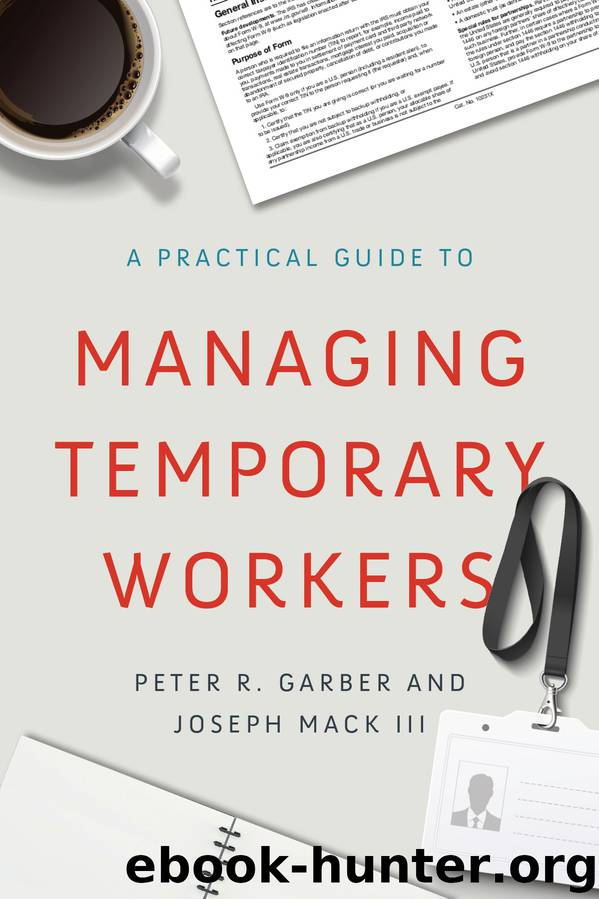A Practical Guide to Managing Temporary Workers by Peter Garber Joseph Mack III

Author:Peter Garber,Joseph Mack III [Garber, Peter R.; Mack III, Joseph]
Language: eng
Format: epub
ISBN: 9781947308671
Publisher: Association for Talent Development
Published: 2018-04-14T16:00:00+00:00
Open Communication
Effective communication is extremely important in the remote work environment. There shouldn’t be “silent expectations”—that is, responsibilities that aren’t clearly communicated to these workers but are still expected. Supervisors need to understand what communications and information they must share. They need to not only establish effective communications with these workers, but help them become better communicators as well. Everyone needs to both speak up and listen to one another; it needs to be clear who is directly responsible for getting things done. There should be a continuous communications improvement process established, in which these roles and responsibilities are discussed and analyzed to constantly find better ways to define and execute them. When a communication failure does occur, a “postmortem” of the problem should be conducted and corrective measures put in place.
The numerous ways of communicating available can help ensure that supervisors are keeping in touch with remote locations so they can stay connected as much as possible. Real-time sales, production, service verifications, and customer satisfaction surveys can all be instantaneously sent to supervisors not physically present in the workplace. Frequent conference calls, videoconferencing, online production, or sales and service reporting all help a remote manager stay in touch with how contingent workers are performing their jobs without direct supervision and can allow supervisors to keep tabs on how well the work is proceeding or to troubleshoot problems that might be brewing. Also, a remote supervisor can monitor employee attendance, reporting times, and break periods, even if it is one employed by a staffing agency. Providing contingent workers with the ability to call, text, or even tweet at their supervisor with questions or problems can keep a remote supervisor in constant communication with these locations.
Remember, though, all the electronic communications in the world may not be as effective as good old face-to-face interaction in permitting a supervisor to maintain a good relationship with workers and effectively assess their work. To paraphrase an old adage, one visit is as good as a thousand texts.
Download
This site does not store any files on its server. We only index and link to content provided by other sites. Please contact the content providers to delete copyright contents if any and email us, we'll remove relevant links or contents immediately.
| Conflict Resolution & Mediation | Human Resources & Personnel Management |
| Knowledge Capital | Outsourcing |
Bullshit Jobs by David Graeber(3179)
Radical Candor by Kim Scott(2215)
I Am Right, You Are Wrong by Edward De Bono(2107)
23:27 by H. L. Roberts(1891)
Nomadland by Jessica Bruder(1684)
Average Is Over by Tyler Cowen(1541)
High-Impact Interview Questions by Victoria A. Hoevemeyer(1403)
Out of Our Minds: Learning to Be Creative by Ken Robinson(1380)
The Conflict Resolution Phrase Book by Barbara Mitchell & Cornelia Gamlem(1341)
The Ideal Team Player by Patrick M. Lencioni(1316)
The Asshole Survival Guide by Robert I. Sutton(1282)
An Everyone Culture: Becoming a Deliberately Developmental Organization by Robert Kegan & Lisa Laskow Lahey(1281)
Automatic Society by Bernard Stiegler(1220)
Unleashed by Anne Morriss & Frances Frei(1219)
Who by Street Randy & Smart Geoff(1199)
42 Rules of Employee Engagement by Susan Stamm(1191)
Who Moved My Cheese?: An Amazing Way to Deal With Change in Your Work and in Your Life by Johnson Spencer(1178)
96 Great Interview Questions to Ask Before You Hire by Paul Falcone(1132)
The Power of Disability by Al Etmanski(1082)
